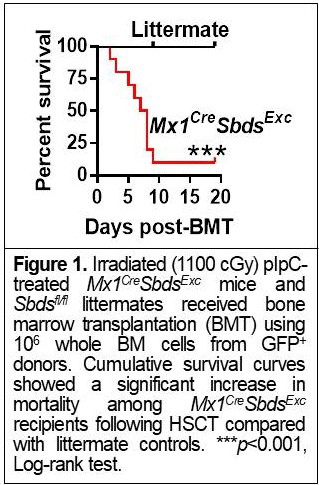Hematopoietic stem cell (HSC) transplantation (HSCT) is required for curative therapy for patients with high-risk hematologic malignancies, and a number of non-malignant disorders including inherited bone marrow failure syndromes (iBMFS). Strategies to enhance bone marrow (BM) niche capacity to engraft donor HSC have the potential to improve HSCT outcome by decreasing graft failure rates and enabling reduction in conditioning intensity and regimen-associated complications. Several studies in animal models of iBMFS have demonstrated that BM niche dysfunction contributes to both the pathogenesis of iBMFS, as well as impaired graft function after HSCT. We hypothesize that such iBMFS mouse models are useful tools for discovering targetable niche elements critical for donor engraftment after HSCT. Here, we report the development of a novel mouse model of Shwachman-Diamond Syndrome (SDS) driven by conditional Sbds deletion, which demonstrates profound impairment of healthy donor hematopoietic engraftment after HSCT due to pathway-specific dysfunctional signaling within SBDS-deficient recipient niches.
We first attempted to delete Sbds specifically in mature osteoblasts by crossing Sbdsfl/flmice with Col1a1Cre+mice. However, the Col1a1CreSbdsExc progenies are embryonic lethal at E12-E15 stage due to developmental musculoskeletal abnormalities. Alternatively, we generated an inducible SDS mouse model by crossing Sbdsfl/flmice with Mx1Cre+ mice, and inducing Sbds deletion in Mx1-inducible BM hematopoietic and osteolineage niche cells by polyinosinic-polycytidilic acid (pIpC) administration. Compared with Sbdsfl/flcontrols, Mx1CreSbdsExc mice develop significantly decreased platelet counts, an inverted peripheral blood myeloid/lymphoid cell ratio, and reduced long-term HSC within BM, consistent with stress hematopoiesis seen in BMF and myelodysplastic syndromes. To assess whether inducible SBDS deficiency impacts niche function to engraft donor HSC, we transplanted GFP+ wildtype donor BM into pIpC-treated Mx1CreSbdsExc mice and Sbdsfl/flcontrols after 1100 cGy of total body irradiation (TBI). Following transplantation, Mx1CreSbdsExc recipient mice exhibit significantly higher mortality than controls (Figure 1). The decreased survival was related to primary graft failure, as Mx1CreSbdsExc mice exhibit persistent BM aplasia after HSCT and decreased GFP+ reconstitution in competitive secondary transplantation assays.
We next sought to identify the molecular and cellular defects within BM niche cells that contribute to the engraftment deficits in SBDS-deficient mice. We performed RNA-seq analysis on the BM stromal cells from irradiated Mx1CreSbdsExc mice versus controls, and the results revealed that SBDS deficiency in BM niche cells caused disrupted gene expression within osteoclast differentiation, FcγR-mediated phagocytosis, and VEGF signaling pathways. Multiplex ELISA assays showed that the BM niche of irradiated Mx1CreSbdsExc mice expresses lower levels of CXCL12, P-selectin and IGF-1, along with higher levels of G-CSF, CCL3, osteopontin and CCL9 than controls. Together, these results suggest that poor donor HSC engraftment in SBDS-deficient mice is likely caused by alterations in niche-mediated donor HSC homing/retention, bone metabolism, host monocyte survival, signaling within IGF-1 and VEGF pathways, and an increased inflammatory state within BM niches. Moreover, flow cytometry analysis showed that compared to controls, the BM niche of irradiated Mx1CreSbdsExc mice contained far fewer megakaryocytes, a hematopoietic cell component of BM niches that we previously demonstrated to be critical in promoting osteoblastic niche expansion and donor HSC engraftment.
Taken together, our data demonstrated that SBDS deficiency in BM niches results in reduced capacity to engraft donor HSC. We have identified multiple molecular and cellular defects in the SBDS-deficient niche contributing to this phenotype. Such niche signaling pathway-specific deficits implicate these pathways as critical for donor engraftment during HSCT, and suggest their potential role as targets of therapeutic approaches to enhance donor engraftment and improve HSCT outcome in any condition for which HSCT is required for cure.
Olson:Merck: Membership on an entity's Board of Directors or advisory committees; Bluebird Bio: Membership on an entity's Board of Directors or advisory committees; Novartis: Membership on an entity's Board of Directors or advisory committees; Miltenyi: Honoraria.
Author notes
Asterisk with author names denotes non-ASH members.


This feature is available to Subscribers Only
Sign In or Create an Account Close Modal